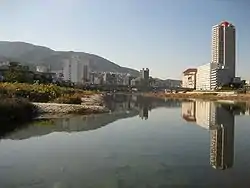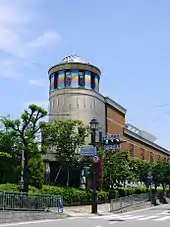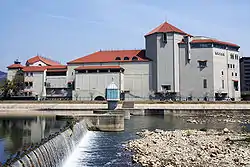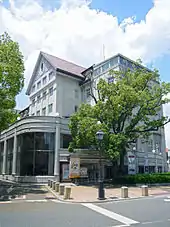Takarazuka
宝塚市 | |
|---|---|
 View of the City in Muko River | |
 Flag  Seal | |
 Location of Takarazuka in Hyōgo Prefecture | |
 Takarazuka Location in Japan | |
| Coordinates: 34°48′41″N 135°20′26″E / 34.81139°N 135.34056°E | |
| Country | Japan |
| Region | Kansai |
| Prefecture | Hyōgo |
| Government | |
| • Mayor | Harue Yamasaki |
| Area | |
| • Total | 101.80 km2 (39.31 sq mi) |
| Population (1 November 2022) | |
| • Total | 224,054 |
| • Density | 2,200/km2 (5,700/sq mi) |
| Time zone | UTC+09:00 (JST) |
| City hall address | 1-1 Tōyō-chō, Takarazuka-shi, Hyōgo-ken 665-8665 |
| Website | Official website |
| Symbols | |
| Bird | Cettia diphone, Motacilla grandis |
| Flower | Viola mandshurica (Japanese violet/sumire) |
| Tree | Camellia sasanqua, Cornus kousa |



Takarazuka (宝塚市, Takarazuka-shi)[1] is a city located in Hyōgo Prefecture, Japan. As of 30 November 2022, the city had an estimated population of 224,054 in 96,463 households and a population density of 2,200 persons per km².[2] The total area of the city is 101.80 square kilometres (39.31 sq mi). Known as the "inner parlor" of Kansai, Takarazuka is famous for the Takarazuka Revue, hot springs, and the Takarazuka Tourism Fireworks Display held since 1913. It is also famous as a choice residential area along with Ashiya and Nishinomiya.
Geography
Takarazuka is located in the northern part of the Hanshin area, surrounded by the Rokko Range to the west and the Nagao mountain range to the north, with the Muko River flowing through the center.
Neighboring municipalities
Hyōgo Prefecture
Climate
Takarazuka has a Humid subtropical climate (Köppen Cfa) characterized by warm summers and cool winters with light snowfall. The average annual temperature in Takarazuka is 14.0 °C. The average annual rainfall is 1578 mm with September as the wettest month. The temperatures are highest on average in January, at around 25.7 °C, and lowest in January, at around 2.6 °C.[3]
Demographics
Per Japanese census data,[4] the population of Takarazuka has been increasing steadily since the 1950s.
| Year | Pop. | ±% |
|---|---|---|
| 1950 | 48,405 | — |
| 1960 | 66,491 | +37.4% |
| 1970 | 127,179 | +91.3% |
| 1980 | 183,628 | +44.4% |
| 1990 | 201,862 | +9.9% |
| 2000 | 213,037 | +5.5% |
| 2010 | 225,587 | +5.9% |
History
The area of Takarazuka was part of ancient Settsu Province and has been inhabited since ancient times, with many kofun burial mounds found within the city limits. The Mefu Jinja dates from the Nara period. From the Heian period, numerous landed estates shōen controlled by the Fujiwara family were developed in the area. Takarazuka onsen is mentioned in Kamakura period records. In the Muromachi period, Kohama town developed as a temple town for Kōshō-ji, and subsequently Kohama Inn was established as a post station on Arima Road. The area was mostly tenryō territory under direct control of the Tokugawa shogunate in the Edo Period.
The village of Kohama (小浜村) was established on April 1, 1889 within Kawabe District, Hyōgo, with the creation of the modern municipalities system. In 1897, Hankaku Railroad (current Fukuchiyama Line) completed. In 1910, the Minoh Arima Electric Railway (current Hankyu Takarazuka Main Line completed). Takarazuka was a center of the culture from the 1910s to 1940s in what has been dubbed the age of Hanshinkan Modernism. This included the opening of the Takarazuka Girls' Opera (current Takarazuka Revue) on April 1, 1914.
Kohama was elevated to town status on March 15, 1951, changing its name to Takarazuka. On April 1 1954 it merged with the village of Yoshimoto (吉本村) in Muko District to become the city of Takarazuka. The city continued to expand by annexing Nagao Village on March 10, 1955, and Nishitani Village on March 14, 1955, but losing some areas in a border adjustment with the city of Itami on April 1, 1955. On January 17, 1995 the Great Hanshin earthquake caused more than 100 casualties. Takarazuka was designated as a Special City on April 1, 2003 with increased autonomy.
At one time, the idea was raised of merging Takarazuka with Itami, Kawanishi, and Inagawa, but it is currently on hold.
Government
Takarazuka has a mayor-council form of government with a directly elected mayor and a unicameral city council of 26 members. Takarazuka contributes three members to the Hyōgo Prefectural Assembly. In terms of national politics, the city is divided between the Hyōgo 6th districts of the lower house of the Diet of Japan.
Economy
Takarazuka has a mixed economy of commerce, manufacturing and market gardening. It is increasing a bedroom community for Osaka and Kobe, with quiet, upscale residential neighborhoods like Nigawa, Obayashi, Sakasegawa, and Hibarigaoka.
Companied headquartered in Takarazuka
- HI-LEX Corporation, a manufacturer of remote-controlling cables and accessories for multiple applications is headquartered in the city.[5]
- ShinMaywa Industries, a manufacturer of military aircraft (especially seaplanes) and heavy duty trucks is headquartered in the city.[6]
Education
- Universities and colleges
- Primary and secondary schools
Takazuka has 23 public elementary schools and 12 public middle schools operated by the city government, and five public high schools operated by the Hyōgo Prefectural Board of Education. There are three private elementary schools, two private middle schools and two private high schools. In addition, the prefecture also operates one special education school for the handicapped.
Transportation
Railways
Kawanishi is serviced by the JR Takarazuka Line and the Hankyu Takarazuka Line. Hankyu's Kawanishi-Noseguchi Station is a transfer station to the Nose Railway, which runs primarily within Kawanishi.
Highways
Buses
- Hankyu Bus
- Hanshin Dentetsu Bus
- Hankyu Country Bus
- Shinki Bus
Twin towns – sister cities
Takarazuka is twinned with:[7]
 Alsergrund (Vienna), Austria
Alsergrund (Vienna), Austria Augusta, United States
Augusta, United States
Local attractions

Specialty products
Places
- Takarazuka Grand Theatre (宝塚大劇場, Takarazuka Dai Gekijō)
- Takarazuka Bow Hall
- Flower Road (花のみち, Hana-no Michi)
- Hanshin Racecourse (阪神競馬場, Hanshin-keibajō)
- Takarazuka Hot Spring (宝塚温泉, Takarazuka Onsen)
- Osamu Tezuka Manga Museum (手塚治虫記念館, Tezuka Osamu Kinen-kan)
- Takarazuka Hotel
- Tessai Art Museum (鉄斎美術館, Tessai Bijutsu-kan)
- Takedao Hot Spring (武田尾温泉, Takedao Onsen)
- Shōji Residence (正司邸): Mixed Western- and Japanese-style mansion built in 1918–1919. (Designed by Masaharu Furuzuka. National Registry of Tangible Cultural Properties. Filming location for NHK drama Twins (ふたりっ子, Futarikko).)
- Takarazuka City Historical Archives (former Matsumoto Residence): Western-style mansion built in 1937. (National Registry of Tangible Cultural Properties)
- Kohama Inn Resource Center (小浜宿資料館, Kohama-juku Shiryō-kan)
- Nomura Koumuten House (Designed by Antonino Cardillo in 2009)[8]
Religious institutions
- Temples
- Shrines
Sightseeing and festivals

- Takarazuka Revue
- Flower Road
- Takarazuka Tourism Fireworks Display
- Takarazuka Memorial (horse race)
Notable people from Takarazuka
- Saki Aibu, actress and celebrity
- Kyoko Hikami, voice actress
- Makoto Imaoka, professional baseball player
- Minami Itahashi, Olympic diver
- Shinji Okazaki, footballer
- Akira Raijin, professional wrestler
- Kosaku Shimada, professional golfer
- Osamu Tezuka, cartoonist
- Seigo Yamamoto, drift driver
- Tarō Yamamoto, actor and politician

References
- ↑ The kanji 塚 (UTF-8 code FA1016), which is part of Takarazuka's official name (宝塚市), is not available on all systems. (It can be entered in Wikipedia with HTML character
塚.) When not available, the kanji 塚 (UTF-8 code 585A16, HTML character塚) is used as a substitute, rendering Takarazuka as 宝塚市. ("Shirabetemimashita 'Takarazukashi' no zuka to ZU" (PDF). Kōhō Takarazuka (in Japanese). 1026: 8. 2004-06-15. Archived from the original (PDF) on 2007-09-27. Retrieved 2007-03-05.) - ↑ "Takarazuka city official statistics" (in Japanese). Japan.
- ↑ Takarazuka climate data
- ↑ Takarazuka population statistics
- ↑ "HI-LEX". Retrieved 5 March 2014.
- ↑ "Shin Maywa". Retrieved 20 October 2019.
- ↑ "国際交流のページ". city.takarazuka.hyogo.jp (in Japanese). Takarazuka. Retrieved 2020-04-11.
- ↑ Cardillo, Antonino (March 1, 2010). "The Inexact Quality". www.antoninocardillo.com. Retrieved June 19, 2022.
External links
- Takarazuka City official website (in Japanese)
- Takarazuka City official website
- Takarazuka Revue
- Osamu Tezuka Manga Museum (in Japanese)
 Geographic data related to Takarazuka, Hyōgo at OpenStreetMap
Geographic data related to Takarazuka, Hyōgo at OpenStreetMap